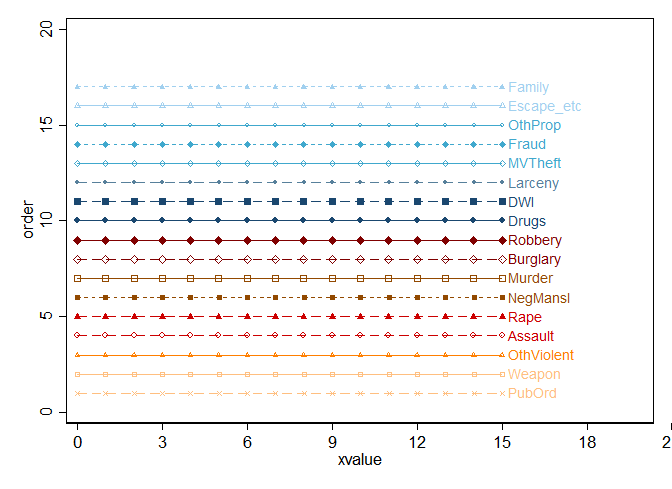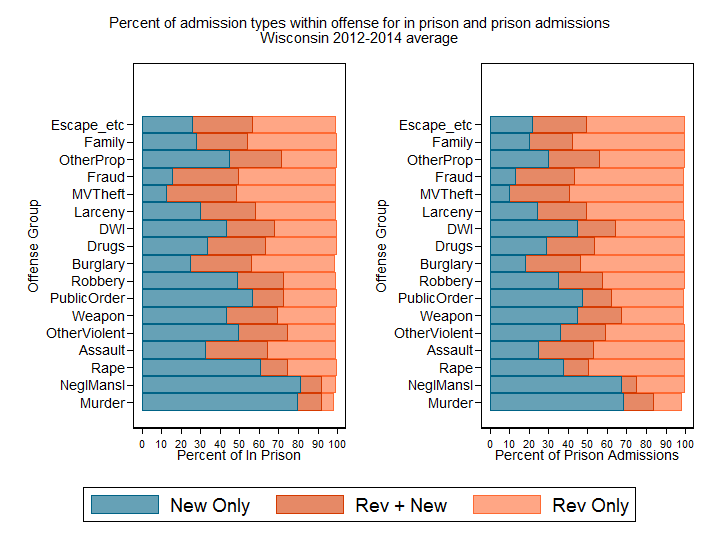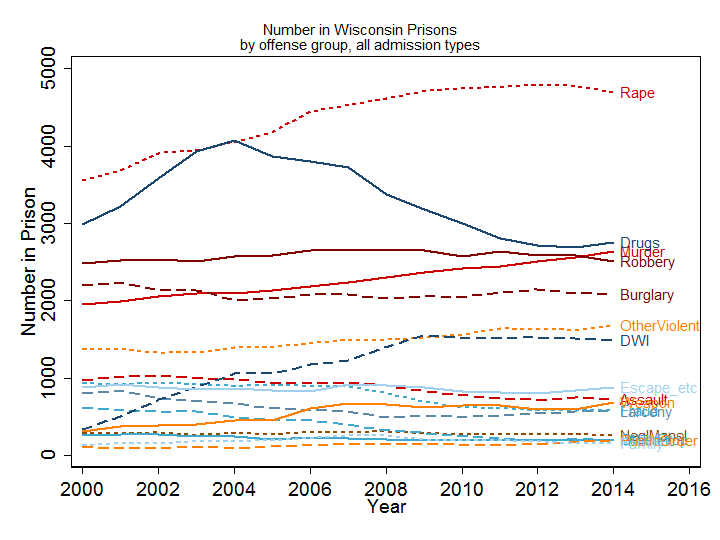In his Scatterplot post algorithmic-decisionmaking-replaces-your-biases-with-someone-elses-biases Sociologist Dan Hirschman has written a good summary (with links) of recent discussions of the problems with COMPAS, a “risk assessment” tool that is used to decide whether people are released from prison or jail. He calls particular attention to the story in Rebecca Wexler’s
Read more
Stata code for designing custom graph colors
A few readers may be interested in how I used Stata to create the color scheme for the offenses in the graphs I’ve posted recently. This is a “stats nerd” post that assumes the reader uses Stata, a statistical package. Everybody else may wish to give it a pass. Some
Read moreAnother bad idea: automatic revocation if charged with a crime
Hopefully the enormous costs will dissuade legislators from passing a bill that would require the Wisconsin Department of Corrections to automatically recommend revocation of anyone “charged with a crime.” The bill literally says “charged with a crime.” Not a felony, not a violent crime, “a crime.” Although ordinances that are
Read moreClock restarting and Wisconsin’s Revocation Problem
A quirk in Wisconsin’s Truth in Sentencing law increases the “churning” in and out of prison via revocation and creates the possibility for massive injustice & increases costs.[i] A Wisconsin sentence has a total length that is divided into two parts, imprisonment and extended supervision in the community. If a
Read more
Offense, Admission Types, In Prison Vs. Admitted
I’ve written several posts trying to clarify the reasons you will get a different mix of offenders in a snapshot of who is in prison versus the flow of prison admissions. This also comes up as we compare the combination of offense type and admission type. To illustrate this,
Read more
Wisconsin Imprisonment Trends By Offense
A reporter’s inquiry led me to look into the changing mix of offenses among people in Wisconsin’s prisons 2000-2014. This is a short version of a longer report about what what I found. A report in the Wisconsin Taxpayer Magazine provides a substantial amount of analysis, including summaries of important policies
Read moreCreating Protest Event Databases: A New Protocol
In constructing and analyzing new data on Black protests, I’ve come to realize the importance of improving standard protocols for collecting protest event data. Although protest event data has one record per event, these events are recorded in news accounts that talk about multiple events in one article and the
Read moreVictim or villain? Racial/ethnic differences in the portrayal of individuals with mental illness killed by police
News reports about individuals killed by police have dominated the news cycle in the past few years. But how are individuals killed by police portrayed in the media? Are there racial/ethnic differences in media portrayals? If there are differences, what are the implications for public perceptions of these killings? In
Read moreIntra-movement ethnic/racial conflicts
It is usually difficult for groups to work together across racial-ethnic divides. Research across a wide variety of movements reveals common tensions. I list below some of the common patterns and provide a partial list of references at the end. The first two patterns apply to all groups, whether their relationship
Read moreWhy A Wall Won’t Work
This humorous video made in 2015 provides a sociological explanation for why a wall does not block unauthorized immigration and why tightened border controls beginning with President Reagan paradoxically actually increased the number of undocumented immigrants. It does not address the question of whether immigration is good or bad and
Read more